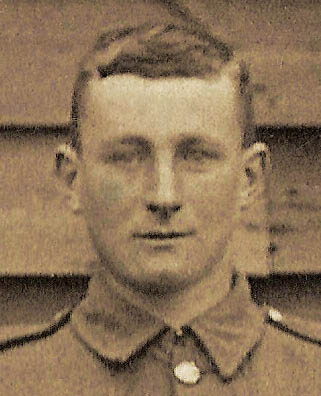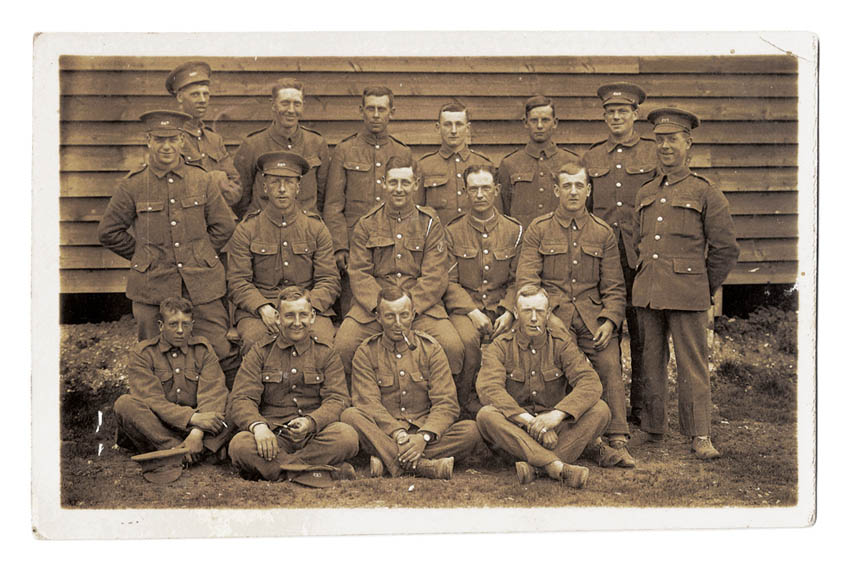James, known as Ben, served with the Royal Naval Division
during the war.
James Herbert Friar, known as Ben, was born on 30th June 1896 in Melton Suffolk. In 1911, he was assisting his father in the family business.
Ben was conscripted into the services and joined the Army Reserve on 2nd March 1916. On 18th October that year, he was called up and joined the Royal Naval Division’s 4th Reserve Battalion, based at Blandford in Dorset. He remained at Blandford for the next year undergoing training and, on 11th January 1918, he received notification that he would be sent to the front line to serve with Hawke Battalion. On 14th February 1918, the newly-promoted Able Seaman James Friar embarked from Folkestone, arriving in Boulogne the following day. Ben joined Hawke Battalion in the field on 2nd March with nineteen other men from the Divisional Wing. Four days later, on the 6th March, he was on the front line for the first time in what was called “Unseen Trench” near to Premy on the Somme.
The war diary reports that the relief went well and was completed by 21:15. The following day was quiet, with enemy aircraft observed in the skies above the lines. On the 8th, the battalion came under heavy shell fire and took some casualties. The 9th was reported to be quiet once again, with the enemy artillery less active. The next day the battalion was relieved and went into support in “Unseen Support” trench.
From 12th March, the German artillery continually shelled the area around “Unseen Trench” and “Unseen Support” with gas shells resulting in one hundred and thirty-five casualties. The writer of the war diary estimated that on the 13th alone they had been on the receiving end of over ten thousand gas shells, causing a further one hundred and twenty-seven casualties. One hundred and eighty-one reinforcements arrived on the 14th to replace the wounded from the previous two days. On March 15th, a new barrage of gas shells was put down on the trenches where Ben was posted, causing Hawke Battalion to suffer a further one hundred and thirteen casualties – one of which was Ben.
He was taken to the 149th (Royal Naval) Field Ambulance for treatment and then on to No. 3 Casualty Clearing Station. Ben was then taken by the No.11 Ambulance Train to the 1st Australian General Hospital in Rouen where his condition was deemed severe enough to require treatment in England. On 23rd March, he was on his way to the Town Hall Hospital in Torquay. It was not until the end of May that Ben was well enough to be discharged from hospital and he was given ten days sick furlough before having to return to the Royal Naval Division depot at Blandford.
James Friar outside his barrack hut at Blandford. James is the third from the right on the back row.
Ben remained at Blandford until 20th August 1918 when he was drafted back to France to re-join Hawke Battalion. He landed in Calais and went straight to the divisional reception camp before joining his battalion once again on the 1st October at Annaux – not far from where he had been gassed in March – after a further spell of time in a casualty clearing station.
The next few days, the battalion went through a period of reorganisation and training ready to make an attack on the 7th October; Ben was admitted to the 2/3rd Wessex Casualty Clearing Station for treatment for an accidental injury and missed out on the action. He returned to Hawke on the 10th when they entrained to Moncheaux and then on to billets and training at Grand-Rullecourt, France. On the 1st November, Hawke Battalion was on the move again, heading to Angre in Belgium. They relieved the London Scottish on the 7th November and, in the morning, advanced on Audregnies, capturing it from the retreating German army. During the advance, gas shells were fired on the battalion and Ben was affected for a second time. He was transported to No. 16 General Hospital at Le Treport and was there, on the 11th November, when the Armistice commenced.
Ben was kept in hospital and his family were informed that he had been wounded once more. Almost a month after being gassed Ben was discharged from hospital into the care of the No. 3 Convalescent Depot for a week before returning to Hawke Battalion. Ben remained with Hawke Battalion until 23rd May 1919 when the battalion was shipped home from Dunkirk and, on the 10th June, Ben was demobilised. For his war service, Ben received the British War and Victory Medals.
After the war was over, Ben returned to the family pork butchery business and in 1933, married Ellen Quantrill. They had one child, a son, in 1937. In 1939, the family were living in Eaton House on Melton Road. During the Second World War, Ben was a Special Constable in the East Suffolk Police Force. He died on 12th March 1963 at the age of sixty-six and is buried at Melton Old Church.
